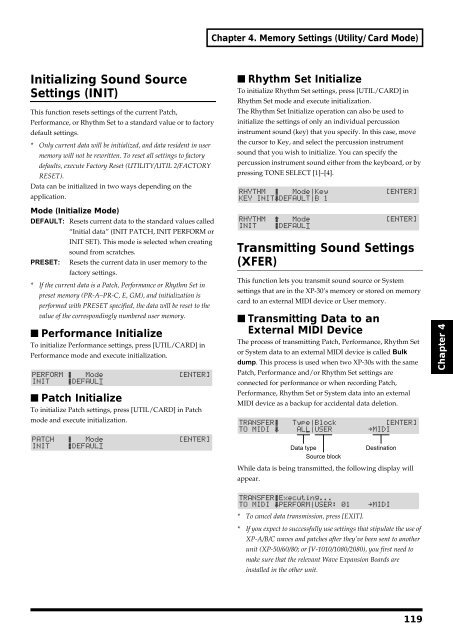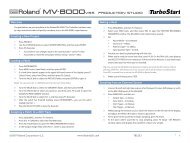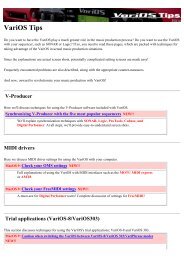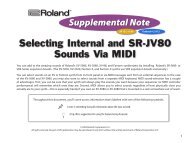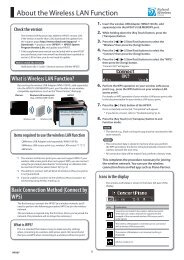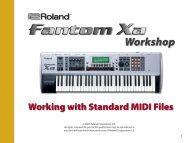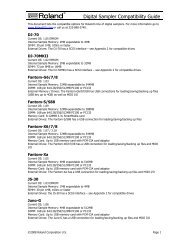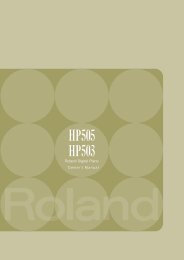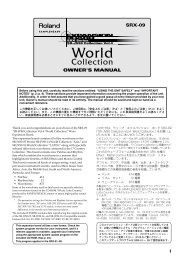You also want an ePaper? Increase the reach of your titles
YUMPU automatically turns print PDFs into web optimized ePapers that Google loves.
Chapter 4. Memory Settings (Utility/Card Mode)<br />
Initializing Sound Source<br />
Settings (INIT)<br />
This function resets settings of the current Patch,<br />
Performance, or Rhythm Set to a standard value or to factory<br />
default settings.<br />
* Only current data will be initialized, and data resident in user<br />
memory will not be rewritten. To reset all settings to factory<br />
defaults, execute Factory Reset (UTILITY/UTIL 2/FACTORY<br />
RESET).<br />
Data can be initialized in two ways depending on the<br />
application.<br />
■ Rhythm Set Initialize<br />
To initialize Rhythm Set settings, press [UTIL/CARD] in<br />
Rhythm Set mode and execute initialization.<br />
The Rhythm Set Initialize operation can also be used to<br />
initialize the settings of only an individual percussion<br />
instrument sound (key) that you specify. In this case, move<br />
the cursor to Key, and select the percussion instrument<br />
sound that you wish to initialize. You can specify the<br />
percussion instrument sound either from the keyboard, or by<br />
pressing TONE SELECT [1]–[4].<br />
fig.4-22<br />
Mode (Initialize Mode)<br />
DEFAULT: Resets current data to the standard values called<br />
“Initial data” (INIT PATCH, INIT PERFORM or<br />
INIT SET). This mode is selected when creating<br />
sound from scratches.<br />
PRESET: Resets the current data in user memory to the<br />
factory settings.<br />
* If the current data is a Patch, Performance or Rhythm Set in<br />
preset memory (PR-A–PR-C, E, GM), and initialization is<br />
performed with PRESET specified, the data will be reset to the<br />
value of the correspondingly numbered user memory.<br />
■ Performance Initialize<br />
To initialize Performance settings, press [UTIL/CARD] in<br />
Performance mode and execute initialization.<br />
fig.4-20<br />
■ Patch Initialize<br />
To initialize Patch settings, press [UTIL/CARD] in Patch<br />
mode and execute initialization.<br />
Transmitting Sound Settings<br />
(XFER)<br />
This function lets you transmit sound source or System<br />
settings that are in the XP-30’s memory or stored on memory<br />
card to an external MIDI device or User memory.<br />
■ Transmitting Data to an<br />
External MIDI Device<br />
The process of transmitting Patch, Performance, Rhythm Set<br />
or System data to an external MIDI device is called Bulk<br />
dump. This process is used when two XP-30s with the same<br />
Patch, Performance and/or Rhythm Set settings are<br />
connected for performance or when recording Patch,<br />
Performance, Rhythm Set or System data into an external<br />
MIDI device as a backup for accidental data deletion.<br />
fig.4-23.e<br />
Chapter 4<br />
fig.4-21<br />
Data type<br />
Source block<br />
Destination<br />
While data is being transmitted, the following display will<br />
appear.<br />
fig.4-24<br />
* To cancel data transmission, press [EXIT].<br />
* If you expect to successfully use settings that stipulate the use of<br />
XP-A/B/C waves and patches after they’ve been sent to another<br />
unit (XP-50/60/80; or JV-1010/1080/2080), you first need to<br />
make sure that the relevant Wave Expansion Boards are<br />
installed in the other unit.<br />
119


